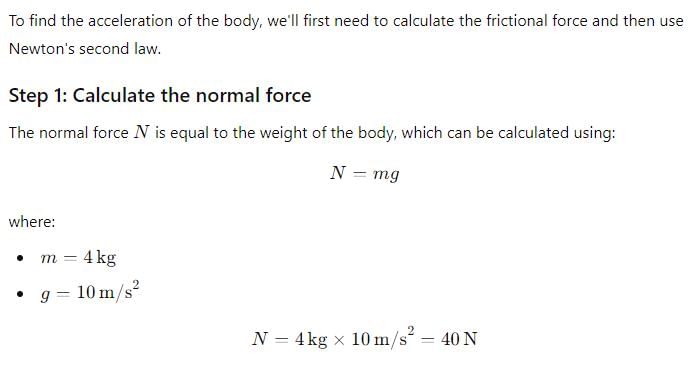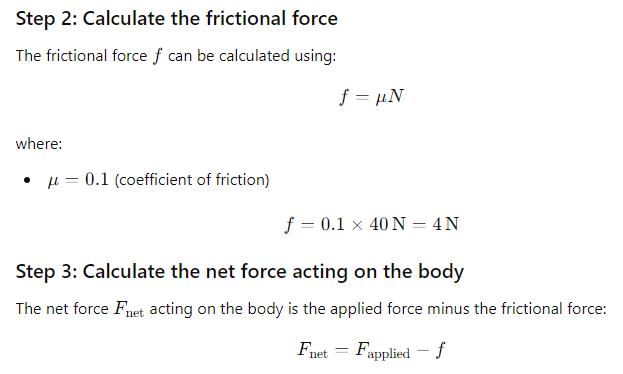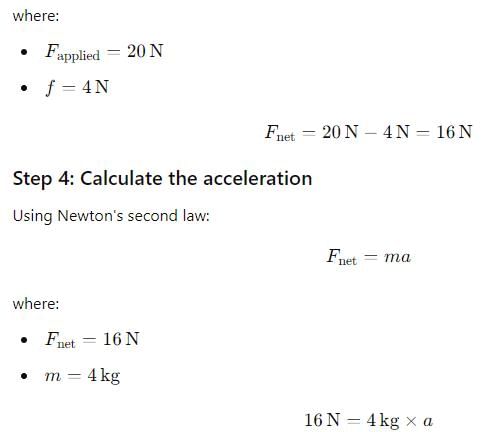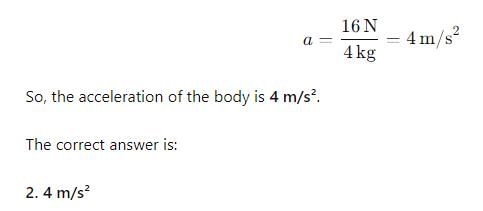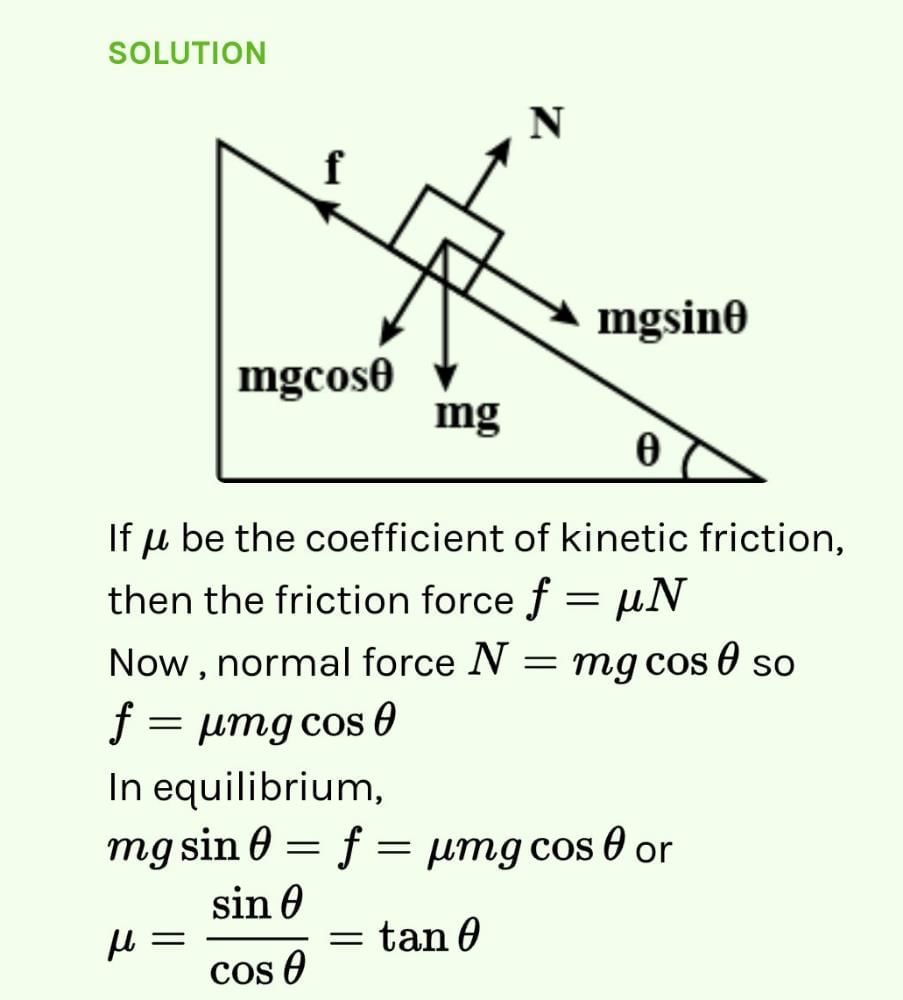All Exams >
NEET >
Physics Class 11 >
All Questions
All questions of Laws of Motion for NEET Exam
For a body to be able to loop a vertical circle of radius R, the minimum velocity required at its lowest point is:- a)

- b)

- c)

- d)

Correct answer is option 'C'. Can you explain this answer?
For a body to be able to loop a vertical circle of radius R, the minimum velocity required at its lowest point is:
a)
b)
c)
d)

|
Ciel Knowledge answered |
For a body able to loop a vertical circle, the tension in the string must not be lesser than zero at the highest point. Hence when the tension at the highest point is zero we will obtain the minimum velocity. I.e.
At the highest point as T = 0, hence we get
Mg = Mv2/R
(comparing the centripetal acceleration with weight, where R is radius of vertical circle)
Hence we get the minimum velocity at the topmost point to be
Thus if we apply the work energy theorem upon the particle from its lowermost point to its top most point, we get net displacement as 2R and thus minimum velocity at lowermost point to be
At the highest point as T = 0, hence we get
Mg = Mv2/R
(comparing the centripetal acceleration with weight, where R is radius of vertical circle)
Hence we get the minimum velocity at the topmost point to be

Thus if we apply the work energy theorem upon the particle from its lowermost point to its top most point, we get net displacement as 2R and thus minimum velocity at lowermost point to be

How is inertia used when riding a bicycle?- a)Bicycles don’t use inertia.
- b)You can stop paddling and still continue rolling forward.
- c)You must paddle harder when going up hill.
- d)You must paddle slower when going up hill.
Correct answer is option 'B'. Can you explain this answer?
How is inertia used when riding a bicycle?
a)
Bicycles don’t use inertia.
b)
You can stop paddling and still continue rolling forward.
c)
You must paddle harder when going up hill.
d)
You must paddle slower when going up hill.
|
|
Suresh Iyer answered |
Due to inertia, even if we stop paddling of motion, we will continue to move forward up to a certain distance as friction will finally make us stop.
Two masses are in the ratio 1:5. What is ratio of their inertia?- a)1:5
- b)5:1
- c)1:25
- d)25:1
Correct answer is option 'A'. Can you explain this answer?
Two masses are in the ratio 1:5. What is ratio of their inertia?
a)
1:5
b)
5:1
c)
1:25
d)
25:1
|
|
Sagar Goyal answered |
Force of inertia = ma
Let the masses be 1x and 5x
Force of inertia for 1st body= 1x * a
Force of inertia for 2nd = 5x * a
Ratio= x * a / 5x * a = 1:5
A block of 5 kg mass rests on a horizontal floor. The action of the block on the floor is- a)50 N vertically upward
- b)5 N vertically upward
- c)5 N vertically downward
- d)50 N vertically downward
Correct answer is option 'D'. Can you explain this answer?
A block of 5 kg mass rests on a horizontal floor. The action of the block on the floor is
a)
50 N vertically upward
b)
5 N vertically upward
c)
5 N vertically downward
d)
50 N vertically downward
|
|
Preeti Iyer answered |
Weight of the block, mg = 5kg x 10 m/s2 = 50 N.
According to Newton’s third law, the action of the block, that is the force exerted on the floor by the block is equal to 50 N in magnitude and is directly vertically downward.
A body of mass 2 kg is hung on a spring balance mounted vertically in a lift. If the lift moves up with an acceleration equal to the acceleration due to gravity, the reading on the spring balance will bea)5 kgb)8 kgc)7 kgd)4 kgCorrect answer is option 'D'. Can you explain this answer?
|
|
Geetika Shah answered |
As the lift moves upwards but the spring feels itself at rest hence we need to compensate the non inertial frame by adding an appropriate pseudo force to treat it as an inertial frame. Hence the pseudo force to be applied acts on every mass in the lift which is equal to mass x acceleration (=g) downwards.
Hence the tension in the spring would be 40N (20 due to weight and 20 pseudo). Thus the reading would be 4kg.
Hence the tension in the spring would be 40N (20 due to weight and 20 pseudo). Thus the reading would be 4kg.
300 J of work is done in sliding a 2 kg block up an inclined plane of height 10 m. Taking g = 10 m/s2, work done against friction is [2006]- a)100 J
- b)zero
- c)1000 J
- d)200 J
Correct answer is option 'A'. Can you explain this answer?
300 J of work is done in sliding a 2 kg block up an inclined plane of height 10 m. Taking g = 10 m/s2, work done against friction is [2006]
a)
100 J
b)
zero
c)
1000 J
d)
200 J

|
Prisha Singh answered |
Work done against gravity = mg sinθ × d = 2 × 10 × 10 (dsinθ = 10) = 200J
Actual work done = 300J
Work done against friction = 300 – 200 = 100J
Actual work done = 300J
Work done against friction = 300 – 200 = 100J
Which law is in control of a spacecraft that cruises through space at a constant speed without using any fuel?- a)Universal law of gravitation
- b)Newton’s third law
- c)Newton’s second law
- d)Newton’s first law
Correct answer is 'D'. Can you explain this answer?
Which law is in control of a spacecraft that cruises through space at a constant speed without using any fuel?
a)
Universal law of gravitation
b)
Newton’s third law
c)
Newton’s second law
d)
Newton’s first law
|
|
Rajveer Kumar answered |
Given information:
- Mass of the object = 6 kg
- Three forces acting on the object:
- F1 = 20i + 30j N
- F2 = 8i - 50j N
- F3 = 2i + 2j N
To find: Acceleration of the object
Solution:
- We know that the net force acting on the object, F_net = F1 + F2 + F3
- Using vector addition, we can find the net force: F_net = (20+8+2)i + (30-50+2)j = 30i - 18j N
- Now, using Newton's second law of motion, F_net = m*a, where m is the mass of the object and a is the acceleration produced.
- Substituting the values, we get: 30i - 18j = 6*a
- Dividing both sides by 6, we get: a = (30/6)i - (18/6)j = 5i - 3j m/s^2
Therefore, the acceleration of the object is 5i - 3j m/s^2, which is option 'B'.
- Mass of the object = 6 kg
- Three forces acting on the object:
- F1 = 20i + 30j N
- F2 = 8i - 50j N
- F3 = 2i + 2j N
To find: Acceleration of the object
Solution:
- We know that the net force acting on the object, F_net = F1 + F2 + F3
- Using vector addition, we can find the net force: F_net = (20+8+2)i + (30-50+2)j = 30i - 18j N
- Now, using Newton's second law of motion, F_net = m*a, where m is the mass of the object and a is the acceleration produced.
- Substituting the values, we get: 30i - 18j = 6*a
- Dividing both sides by 6, we get: a = (30/6)i - (18/6)j = 5i - 3j m/s^2
Therefore, the acceleration of the object is 5i - 3j m/s^2, which is option 'B'.
A block of mass m is pushed by applying a force F at an angle θ with the horizontal surface. The normal force on the block is given as –- a)F = mg – F sin θ
- b)F = mg + F sin θ
- c)F = F sin θ
- d)F = mg
Correct answer is option 'A'. Can you explain this answer?
A block of mass m is pushed by applying a force F at an angle θ with the horizontal surface. The normal force on the block is given as –
a)
F = mg – F sin θ
b)
F = mg + F sin θ
c)
F = F sin θ
d)
F = mg
|
|
Krishna Iyer answered |
Both of them are vector quantities. And both of them can be easily simplified. If taken in the vector form then the task is even easier. Thus it is not necessary for the force or the couple to be vector only, even if the magnitude is taken, the simplification is done in the 2D.
The mass of a lift is 2000 kg. When the tension in the supporting cable is 28000 N, then its acceleration is: [2009]a)4 ms–2 upwardsb)4 ms–2 downwardsc)14 ms–2 upwardsd)30 ms–2 downwardsCorrect answer is option 'A'. Can you explain this answer?
|
|
Gaurav Kumar answered |
The gravitational force in the downward direction is 20000 N and the tension force in the upward direction is 28000 N.
By newton's second law of motion, ΣF=ma
Net force, F = T – mg
ma = T – mg
2000 * a = 28000 – 20000 = 8000
ma = T – mg
2000 * a = 28000 – 20000 = 8000

A monkey of mass 40 kg climbs on a rope which can stand a maximum tension of 600 N. In which of the following cases will the rope break. When the monkey
(a) Climbs up with an acceleration of 6 ms−2.
- a)640 N
- b)632 N
- c)760 N
- d)740 N
Correct answer is option 'A'. Can you explain this answer?
A monkey of mass 40 kg climbs on a rope which can stand a maximum tension of 600 N. In which of the following cases will the rope break. When the monkey
(a) Climbs up with an acceleration of 6 ms−2.
(a) Climbs up with an acceleration of 6 ms−2.
a)
640 N
b)
632 N
c)
760 N
d)
740 N
|
|
Preeti Iyer answered |
Mass of the monkey, m = 40 kg
Acceleration due to gravity, g = 10 m/s
Maximum tension that the rope can bear, Tmax = 600 N
Acceleration of the monkey, a = 6 m/s2 upward
Using Newtons second law of motion, we can write the equation of motion as:
T mg = ma
T = m(g + a)
= 40 (10 + 6)
= 640 N
Since T > Tmax, the rope will break in this case.
Acceleration due to gravity, g = 10 m/s
Maximum tension that the rope can bear, Tmax = 600 N
Acceleration of the monkey, a = 6 m/s2 upward
Using Newtons second law of motion, we can write the equation of motion as:
T mg = ma
T = m(g + a)
= 40 (10 + 6)
= 640 N
Since T > Tmax, the rope will break in this case.
Can you explain the answer of this question below:A horizontal force of 100 N pulls two masses 5 kg and 10 kg tied to each other by a light string. What is the tension in the string if the force is applied on 10 kg mass?

- A:
30 N
- B:
23 N
- C:
43 N
- D:
33.3 N
The answer is d.
A horizontal force of 100 N pulls two masses 5 kg and 10 kg tied to each other by a light string. What is the tension in the string if the force is applied on 10 kg mass?
30 N
23 N
43 N
33.3 N
|
|
Geetika Shah answered |
At first considering both blocks as one system with only one external force F
We get common acceleration at right be a = 100/15 m/s2
Now considering 10 kg block
We get F - T = 10a
i.e. T = 100 - 10(100/15)
= 100 (1 - 2/3)
= 33.33 N
We get common acceleration at right be a = 100/15 m/s2
Now considering 10 kg block
We get F - T = 10a
i.e. T = 100 - 10(100/15)
= 100 (1 - 2/3)
= 33.33 N
A man of mass 70 kg stands on a weighing scale in a lift which is moving upwards with a uniform speed of 10 m s−1, what would be the reading on the scale?- a)105 kg
- b)75 kg
- c)70 kg
- d)35 kg
Correct answer is option 'C'. Can you explain this answer?
A man of mass 70 kg stands on a weighing scale in a lift which is moving upwards with a uniform speed of 10 m s−1, what would be the reading on the scale?
a)
105 kg
b)
75 kg
c)
70 kg
d)
35 kg
|
|
Pooja Shah answered |
Mass of the man, m = 70 kg
Acceleration, a = 0
Using Newton’s second law of motion, We can write the equation of motion as,
R – mg = ma
∴ R = mg = 70 × 10 = 700 N
∴ the weighing scale = 700 / g = 700 / 10 = 70 kg
Acceleration, a = 0
Using Newton’s second law of motion, We can write the equation of motion as,
R – mg = ma
∴ R = mg = 70 × 10 = 700 N
∴ the weighing scale = 700 / g = 700 / 10 = 70 kg
A block of mass 1kg is placed on the floor. The coefficient of static friction is 0.2. If a force of 1N is applied to the block, the force of friction is- a)0
- b)2 N
- c)1 N
- d)varies with the area of contact of the block
Correct answer is option 'C'. Can you explain this answer?
A block of mass 1kg is placed on the floor. The coefficient of static friction is 0.2. If a force of 1N is applied to the block, the force of friction is
a)
0
b)
2 N
c)
1 N
d)
varies with the area of contact of the block

|
Ayush Joshi answered |
The applied force is less than the maximum value of static friction which will be (0.2)(1kg)(10) = 2N. So the force of friction is equal to the applied force.
After the body starts moving, the friction involved with motion is- a)Static Friction
- b)Rolling Friction
- c)Sliding Friction
- d)Kinetic Friction
Correct answer is option 'D'. Can you explain this answer?
After the body starts moving, the friction involved with motion is
a)
Static Friction
b)
Rolling Friction
c)
Sliding Friction
d)
Kinetic Friction
|
|
Gaurav Kumar answered |
When the body is in rest it is under static friction but when it starts moving (neither rolling nor sliding), the static friction slowly chngs to kinetic friction as the coefficient of static friction start decreasing and that of kinetic friction starts increasing. In case it starts rolling motion then the friction is rolling friction & if it slides then sliding fiction.
A lift is moving down with the acceleration 3 m/s2. A ball is released 1.7 m above the the lift floor. How long will it take to hit the lift floor.- a)0.5s
- b)1.7s
- c)7.1s
- d)0.71s
Correct answer is option 'D'. Can you explain this answer?
A lift is moving down with the acceleration 3 m/s2. A ball is released 1.7 m above the the lift floor. How long will it take to hit the lift floor.
a)
0.5s
b)
1.7s
c)
7.1s
d)
0.71s
|
|
Mira Sharma answered |
Relative acceleration is,
a = 9.8 – 3 = 6.8 m/s2
Now, we have
S = ut + (1/2)at2
Here, u = 0 and S = 1.7 m
Therefore, t = 0.71 s
Newton’s third law states that when two bodies interact.- a)they exert forces on each other that at each instant are equal in magnitude and opposite in direction
- b)they exert forces on each other that at each instant are equal in magnitude and same in direction
- c)they exert forces on each other that at some instants are equal in magnitude and opposite in direction
- d)they exert forces on each other that at some instants are equal in magnitude and same in direction
Correct answer is option 'A'. Can you explain this answer?
Newton’s third law states that when two bodies interact.
a)
they exert forces on each other that at each instant are equal in magnitude and opposite in direction
b)
they exert forces on each other that at each instant are equal in magnitude and same in direction
c)
they exert forces on each other that at some instants are equal in magnitude and opposite in direction
d)
they exert forces on each other that at some instants are equal in magnitude and same in direction
|
|
Krishna Iyer answered |
- The third law states that all forces between two objects exist in equal magnitude and opposite direction.
- If one object A exerts a force FA on a second object B, then B simultaneously exerts a force FB on A, and the two forces are equal in magnitude and opposite in direction, FA = −FB
- Newton's third Law:
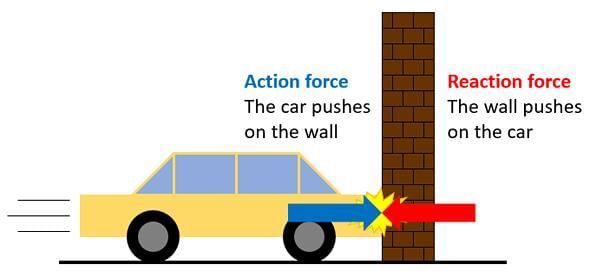
Centripetal force always acts at 90 degrees to the velocity, and away from the centre of the circle.- a)true
- b)cannot predict
- c)false
- d)none of these
Correct answer is option 'C'. Can you explain this answer?
Centripetal force always acts at 90 degrees to the velocity, and away from the centre of the circle.
a)
true
b)
cannot predict
c)
false
d)
none of these
|
|
Anjana Sharma answered |
1. The centripetal force is always towards the centre of the circle.
2. The force always acts at 90 degrees to the direction of the movement.
A man weighing 100kgf carries a load of 10kgf on his head. He jumps from tower with that load. What will be the weight of load experienced by the man.- a)0
- b)110 kgf
- c)10 kgf
- d)slightly more than 10kgf
Correct answer is option 'A'. Can you explain this answer?
A man weighing 100kgf carries a load of 10kgf on his head. He jumps from tower with that load. What will be the weight of load experienced by the man.
a)
0
b)
110 kgf
c)
10 kgf
d)
slightly more than 10kgf

|
Infinity Academy answered |
When an object falls freely, it experiences weightlessness. This is because the object and the load on it are both accelerating towards the ground at the same rate due to gravity. Therefore, the object and the load on it will have the same weight as they would have if they were stationary on the ground.
In this case, the man is carrying a load of 10 kgf on his head and jumps from a tower. As he falls freely, both the man and the load on his head will experience weightlessness. Therefore, the weight of the load experienced by the man will be zero.
Force that produces an acceleration of 1 ms−2 in a body of mass of 1 kg is called- a)slow newton
- b)zero newton
- c)one newton
- d)two newton
Correct answer is option 'C'. Can you explain this answer?
Force that produces an acceleration of 1 ms−2 in a body of mass of 1 kg is called
a)
slow newton
b)
zero newton
c)
one newton
d)
two newton
|
|
Riya Banerjee answered |
We know that F = ma, and for m = 1kg and a = 1m/s2
We get F = 1N which is one newton
We get F = 1N which is one newton
A block of mass m is placed on a smooth wedge of inclination θ. The whole system is accelerated horizontally so that the block does not slip on the wedge. The force exerted by the wedge on the block (g is acceleration due to gravity) will be[2004]- a)mg/cosθ
- b)mg cosθ
- c)mg sinθ
- d)mg
Correct answer is option 'A'. Can you explain this answer?
A block of mass m is placed on a smooth wedge of inclination θ. The whole system is accelerated horizontally so that the block does not slip on the wedge. The force exerted by the wedge on the block (g is acceleration due to gravity) will be[2004]
a)
mg/cosθ
b)
mg cosθ
c)
mg sinθ
d)
mg
|
|
Ananya Das answered |
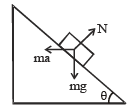
According to Newton's second Law:
N = masinθ + mgcosθ .....(1)
Also, mgsinθ = macosθ .....(2)
Also, mgsinθ = macosθ .....(2)
From (1) & (2) we get, a = gtanθ



A stone is dropped from a height h. It hits the ground with a certain momentum P. If the same stone is dropped from a height 100% more than the previous height, the momentum when it hits the ground will change by : [2012M]- a)68%
- b)41%
- c)200%
- d)100%
Correct answer is option 'B'. Can you explain this answer?
A stone is dropped from a height h. It hits the ground with a certain momentum P. If the same stone is dropped from a height 100% more than the previous height, the momentum when it hits the ground will change by : [2012M]
a)
68%
b)
41%
c)
200%
d)
100%

|
Rajat Roy answered |
Momentum 

(v2 = u2 + 2gh; Here u = 0)
When stone hits the ground momentum

when same stone dropped from 2h (100% of initial) then momentum

Which is changed by 41% of initial.
When a wheel rolls on a level road, the direction of frictional force at the point of contact of wheel and ground is:
- a)along the tangent to the wheel
- b)forward direction
- c)along the centre of the wheel
- d)backward direction
Correct answer is option 'B'. Can you explain this answer?
When a wheel rolls on a level road, the direction of frictional force at the point of contact of wheel and ground is:
a)
along the tangent to the wheel
b)
forward direction
c)
along the centre of the wheel
d)
backward direction

|
Advait Ghoshal answered |
Frictional force is the opposing force which plays between two surfaces and it destroys the relative motion between them. Frictional force is a non-conservative force. The force produced by two surfaces that contact and slide against each other, that force is called the frictional force. These forces are affected by the nature of the surface and amount of force acting on them.
In case of a bicycle, the front wheel of the bicycle is connected to a rod passing through its centre. The force acting on the wheel about its central axis by the force coming from the rest of the bicycle is zero. Front wheel obtains linear velocity by pedalling but it cannot rotate it.
Wheel or ball can also be rolled by pushing on it. The frictional force prevents the wheel from sliding forward at the point of contact. Here, the frictional force prevents the wheel from sliding forward and it is in the opposite direction.
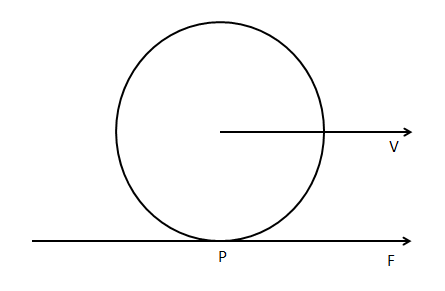
So, in the case of the wheel, the point P which is in contact with the ground tries to go backward due to rotation. Frictional force will oppose this motion. Hence it will move forward.
Hence the direction of frictional force at the point P of the wheel is in forward direction.
Note: Frictional force opposes the motion. Here static friction holds a wheel or a ball on the surface. Frictional force is equal and opposite in direction to the applied force parallel to the contacting surfaces. The resistance due to the rolling body on a surface is called rolling friction. Torque is a force that acts on a body that is undergoing rotation.
Three blocks with masses m, 2 m and 3 m are connected by strings as shown in the figure.After an upward force F is applied on block m, the masses move upward at constant speed v.What is the net force on the block of mass 2m? (g is the acceleration due to gravity) [NEET 2013]
- a)2 mg
- b)3 mg
- c)6 mg
- d)zero
Correct answer is option 'D'. Can you explain this answer?
Three blocks with masses m, 2 m and 3 m are connected by strings as shown in the figure.After an upward force F is applied on block m, the masses move upward at constant speed v.What is the net force on the block of mass 2m? (g is the acceleration due to gravity) [NEET 2013]

a)
2 mg
b)
3 mg
c)
6 mg
d)
zero

|
Diya Datta answered |
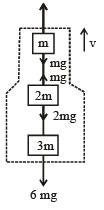
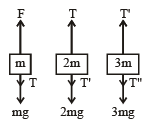
From figure F = 6 mg, As speed is constant, acceleration a = 0
∴ 6 mg = 6ma = 0, F = 6 mg
∴ T = 5 mg , T' = 3 mg T" = 0
Fnet on block of mass 2 m = T – T' – 2 mg = 0
ALTERNATE :
v = constantso, a = 0, Hence, Fnet = ma = 0
∴ 6 mg = 6ma = 0, F = 6 mg
∴ T = 5 mg , T' = 3 mg T" = 0
Fnet on block of mass 2 m = T – T' – 2 mg = 0
ALTERNATE :
v = constantso, a = 0, Hence, Fnet = ma = 0
Impending motion of a body is opposed by- a)sliding friction
- b)rolling friction
- c)static friction
- d)kinetic friction
Correct answer is option 'C'. Can you explain this answer?
Impending motion of a body is opposed by
a)
sliding friction
b)
rolling friction
c)
static friction
d)
kinetic friction

|
Arunaditya Das answered |
Impending motion is opposed by static friction..because it is the time when the object is going to slip in one direction...so that slipping of the object is opposed by static friction(max)...as soon as it starts moving friction becomes kinetic
If second law is applied to a rigid body- a)the acceleration is that of the centre of mass
- b)the acceleration is the average of all particles in the body
- c)the acceleration is that of any particle in the body
- d)none of the above
Correct answer is option 'A'. Can you explain this answer?
If second law is applied to a rigid body
a)
the acceleration is that of the centre of mass
b)
the acceleration is the average of all particles in the body
c)
the acceleration is that of any particle in the body
d)
none of the above
|
|
Geetika Shah answered |
The net external force on the rigid body is always equal to the total mass times the translational acceleration (i.e., Newton's second law holds for the translational motion, even when the net external torque is nonzero, and/or the body rotates).
A person of mass 60 kg is inside a lift of mass 940 kg and presses the button on control panel.The lift starts moving upwards with an acceleration 1.0 m/s2. If g = 10 ms–2, the tension in the supporting cable is [2011]- a)8600 N
- b)9680 N
- c)11000 N
- d)1200 N
Correct answer is option 'C'. Can you explain this answer?
A person of mass 60 kg is inside a lift of mass 940 kg and presses the button on control panel.The lift starts moving upwards with an acceleration 1.0 m/s2. If g = 10 ms–2, the tension in the supporting cable is [2011]
a)
8600 N
b)
9680 N
c)
11000 N
d)
1200 N

|
Mahesh Saini answered |
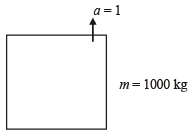
Total mass = (60 + 940) kg = 1000 kg
Let T be the tension in the supporting cable, then T – 1000g = 1000 × 1
⇒ T = 1000 × 11 = 11000 N
Let T be the tension in the supporting cable, then T – 1000g = 1000 × 1
⇒ T = 1000 × 11 = 11000 N
A person slides freely down a frictionless inclined plane while his bag falls down vertically from the same height. The final speeds of the man (VM) and the bag (VB) should be such that [2000]- a)VM < VB
- b)VM = VB
- c)they depend on the masses
- d)VM > VB
Correct answer is option 'B'. Can you explain this answer?
A person slides freely down a frictionless inclined plane while his bag falls down vertically from the same height. The final speeds of the man (VM) and the bag (VB) should be such that [2000]
a)
VM < VB
b)
VM = VB
c)
they depend on the masses
d)
VM > VB

|
Nilotpal Gupta answered |
As there is only gravitational field which works.
We know it is conservative field and depends only on the end points. So, VM = VB
We know it is conservative field and depends only on the end points. So, VM = VB
A constant retarding force of 50 N is applied to a body of mass 20 kg moving initially with a speed of 15 m s−1How long does the body take to stop?- a)1.7.0 s
- b)6.0 s
- c)5.0 s
- d)none
Correct answer is option 'B'. Can you explain this answer?
A constant retarding force of 50 N is applied to a body of mass 20 kg moving initially with a speed of 15 m s−1How long does the body take to stop?
a)
1.7.0 s
b)
6.0 s
c)
5.0 s
d)
none
|
|
Lavanya Menon answered |
According to Newton's second Law
Force = mass x accleration
F = m.a
= m.v/t
t = m.v/F
= 20x15/50
= 6 sec
Force = mass x accleration
F = m.a
= m.v/t
t = m.v/F
= 20x15/50
= 6 sec
A particle of mass M, originally at rest is subjected to a force whose direction is constant but whose magnitude varies with the time according to the relation

where F0 and T are constant. The force acts only for the time interval 2T. Find the velocity v of the particle after time 2T.
- a)F0/3M
- b)4F0/3M
- c)F0/2M
- d)none of the above
Correct answer is option 'B'. Can you explain this answer?
A particle of mass M, originally at rest is subjected to a force whose direction is constant but whose magnitude varies with the time according to the relation

where F0 and T are constant. The force acts only for the time interval 2T. Find the velocity v of the particle after time 2T.
where F0 and T are constant. The force acts only for the time interval 2T. Find the velocity v of the particle after time 2T.
a)
F0/3M
b)
4F0/3M
c)
F0/2M
d)
none of the above

|
R L Sharma answered |
I think this statement is said by Aristotle as every body is in the natural state of rest. and it get in the state of motion ony when some external force is applied on it.
A block of mass 2kg rests on a plane inclined at an angle of 30o with the horizontal. The coefficient of friction between the block and the surface is 0.7. The frictional force acting on the block is
- a)9.8N
- b)0.7×9.8×3–√N
- c)12.5 N
- d)0.7×9.8N
Correct answer is option 'A'. Can you explain this answer?
A block of mass 2kg rests on a plane inclined at an angle of 30o with the horizontal. The coefficient of friction between the block and the surface is 0.7. The frictional force acting on the block is
a)
9.8N
b)
0.7×9.8×3–√N
c)
12.5 N
d)
0.7×9.8N
|
|
Rohan Singh answered |
Since the frictional force is self adjusting, the weight component acting down the inclined plane is mgsin?, which comes out to be 2 x 10 sin 30 = 10 N. So the frictional force balancing this downward force will also be 10 N acting up the plane.
A monkey of mass 40 kg climbs on a rope which can stand a maximum tension of 600 N. What is the tension in the rope if the monkey climbs down with an acceleration of 4 ms−2- a)200 N
- b)300 N
- c)240 N
- d)280 N
Correct answer is option 'C'. Can you explain this answer?
A monkey of mass 40 kg climbs on a rope which can stand a maximum tension of 600 N. What is the tension in the rope if the monkey climbs down with an acceleration of 4 ms−2
a)
200 N
b)
300 N
c)
240 N
d)
280 N
|
|
Lavanya Menon answered |
Mass of the monkey, m = 40 kg
Acceleration due to gravity, g = 10 m/s
Maximum tension that the rope can bear, Tmax = 600 N
Acceleration of the monkey, a = 4 m/s2 downward
Using Newton’s second law of motion, we can write the equation of motion as:
mg T = ma
T = m (g- a)
= 40(10-4)
= 240 N
Acceleration due to gravity, g = 10 m/s
Maximum tension that the rope can bear, Tmax = 600 N
Acceleration of the monkey, a = 4 m/s2 downward
Using Newton’s second law of motion, we can write the equation of motion as:
mg T = ma
T = m (g- a)
= 40(10-4)
= 240 N
A model aeroplane is tethered to a post and held by a fine line. It flies in a horizontal circle. Then the line breaks. What direction will it fly in?
- a)In a circular path, as before
- b)Directly to the centre of the circle
- c)In a straight line at a tangent
- d)Directly away from the centre of the circle
Correct answer is option 'C'. Can you explain this answer?
A model aeroplane is tethered to a post and held by a fine line. It flies in a horizontal circle. Then the line breaks. What direction will it fly in?
a)
In a circular path, as before
b)
Directly to the centre of the circle
c)
In a straight line at a tangent
d)
Directly away from the centre of the circle
|
|
Preeti Iyer answered |
It is because at every point of circle an object has two acceleration (Tangential & Angular acceleration).At every point a body experience a tangential force which is perpendicular to the radius of the circle, when the string breaks the centripetal force disappear ( the radially inward force which holds a body in a circular motion) Hence the only Tangential force act on the body & it goes in that way.
Which of the following is called a fictitious force?- a)Gravitational force
- b)Frictional force
- c)Centrifugal force
- d)Centripetal force
Correct answer is option 'C'. Can you explain this answer?
Which of the following is called a fictitious force?
a)
Gravitational force
b)
Frictional force
c)
Centrifugal force
d)
Centripetal force
|
|
Nandini Patel answered |
Centrifugal force, a fictitious force, peculiar to a particle moving on a circular path, that has the same magnitude and dimensions as the force that keeps the particle on its circular path (the centripetal force) but points in the opposite direction.
A body rests on an inclined plane and the angle of inclination is varied till the body just begins to slide down. The coefficient of friction is  . What is the angle of inclination?
. What is the angle of inclination?- a)45o
- b)60o
- c)15o
- d)30o
Correct answer is option 'D'. Can you explain this answer?
A body rests on an inclined plane and the angle of inclination is varied till the body just begins to slide down. The coefficient of friction is  . What is the angle of inclination?
. What is the angle of inclination?
 . What is the angle of inclination?
. What is the angle of inclination?a)
45o
b)
60o
c)
15o
d)
30o
|
|
Preeti Iyer answered |
At the time when the block just starts to move, we get that net force acting upon it is 0, thus we get, f - mg.sin a = 0
Where f is friction force and a is angle of incline.
We also know that f = 1√3 x N
= 1√3 x mg.cos a
Thus we get 1√3 x mg.cos a = mg.sin a
Thus we get tan a = 1√3
And a = 30
Where f is friction force and a is angle of incline.
We also know that f = 1√3 x N
= 1√3 x mg.cos a
Thus we get 1√3 x mg.cos a = mg.sin a
Thus we get tan a = 1√3
And a = 30
A stone of mass 5 kg is attached to a string of 10 m length and is whirled in a horizontal circle. The string can withstand a maximum tension of 160 N. The maximum velocity of revolution that can be given to the stone without breaking the string is- a)17.88 m/s
- b)16 m/s
- c)20 m/s
- d)19.4 m/s
Correct answer is option 'A'. Can you explain this answer?
A stone of mass 5 kg is attached to a string of 10 m length and is whirled in a horizontal circle. The string can withstand a maximum tension of 160 N. The maximum velocity of revolution that can be given to the stone without breaking the string is
a)
17.88 m/s
b)
16 m/s
c)
20 m/s
d)
19.4 m/s
|
|
Mira Sharma answered |
maximum tension = (mv^2)/ r,
60 = 5*v^2/10
v = 17.88
v = 17.88
A block of mass m is pulled by applying a force F at an angle θ with the horizontal surface. Its acceleration will be given by- a)

- b)

- c)

- d)

Correct answer is option 'C'. Can you explain this answer?
A block of mass m is pulled by applying a force F at an angle θ with the horizontal surface. Its acceleration will be given by
a)
b)
c)
d)
|
|
Lavanya Menon answered |
When the force F is applied at some angle, only the component of it which is parallel to the surface would provide acceleration to it. The other one would be balanced by the normal force. Hence as the component parallel to the surface is F.cosΘ , we get a = F.cosΘ / m
A particle of mass 'm' original at rest, is subjected to a force whose direction is constant but whose magnitude varies with according to the relation
 Where F0 and T are constant.
Where F0 and T are constant.
Then speed of the particle after a time 2T is:
- a)

- b)

- c)

- d)

Correct answer is option 'C'. Can you explain this answer?
A particle of mass 'm' original at rest, is subjected to a force whose direction is constant but whose magnitude varies with according to the relation


Where F0 and T are constant.
Then speed of the particle after a time 2T is:
Then speed of the particle after a time 2T is:
a)

b)

c)

d)


|
Cstoppers Instructors answered |
Given:

Speed of the particle after a time 2T,





Two bodies of masses 10 kg and 20 kg respectively kept on a smooth, horizontal surface are tied to the ends of a light string. a horizontal force F = 600 N is applied to the 20 kg mass so as to pull it. What is the tension in the string?- a)250 N
- b)300 N
- c)150 N
- d)200 N
Correct answer is option 'D'. Can you explain this answer?
Two bodies of masses 10 kg and 20 kg respectively kept on a smooth, horizontal surface are tied to the ends of a light string. a horizontal force F = 600 N is applied to the 20 kg mass so as to pull it. What is the tension in the string?
a)
250 N
b)
300 N
c)
150 N
d)
200 N
|
|
Lavanya Menon answered |
For some instance assume both masses as one system, thus we get that
600 = 30a
Where a is the common acceleration of the system.
Now if we consider the 10kg block we get that
T = 10a
And a = 20m/s2
Thus we get T = 200N
600 = 30a
Where a is the common acceleration of the system.
Now if we consider the 10kg block we get that
T = 10a
And a = 20m/s2
Thus we get T = 200N
A car is moving in a circular horizontal track of radius 10 m with a constant speed of 10 m/s. A bob is suspended from the roof of the car by a light wire of length 1.0 m. The angle made by the wire with the vertical is [NEET Kar. 2013]- a)0°
- b)

- c)

- d)

Correct answer is option 'D'. Can you explain this answer?
A car is moving in a circular horizontal track of radius 10 m with a constant speed of 10 m/s. A bob is suspended from the roof of the car by a light wire of length 1.0 m. The angle made by the wire with the vertical is [NEET Kar. 2013]
a)
0°
b)

c)

d)


|
Kunal Rane answered |
Given; speed = 10 m/s; radius r = 10 m
Angle made by the wire with the vertical


Starting from rest, a body slides down a 45° inclined plane in twice the time it takes to slide down the same distance in the absence of friction.The coefficient of friction between the body and the inclined plane is [1988]- a)0.80
- b)0.75
- c)0.25
- d)0.33
Correct answer is option 'B'. Can you explain this answer?
Starting from rest, a body slides down a 45° inclined plane in twice the time it takes to slide down the same distance in the absence of friction.The coefficient of friction between the body and the inclined plane is [1988]
a)
0.80
b)
0.75
c)
0.25
d)
0.33

|
Anand Jain answered |
In presence of friction a = (g sinθ – μg cosθ)
∴ Time taken to slide down the plane

In absence of friction




Sand is being dropped on a conveyor belt at the rate of M kg/s. The force necessary to keep the belt moving with a constant velocity of v m/s will be:[2008]- a)Mv newton
- b)2 Mv newton
- c)

- d)zero
Correct answer is option 'A'. Can you explain this answer?
Sand is being dropped on a conveyor belt at the rate of M kg/s. The force necessary to keep the belt moving with a constant velocity of v m/s will be:[2008]
a)
Mv newton
b)
2 Mv newton
c)

d)
zero

|
Shanaya Rane answered |

∴ v is constant,

∴ F = vM newton.
According to second law of motion- a)The momentum of a body is directly proportional to the applied force and takes place in the direction in which the force acts
- b)The change of momentum of a body is directly proportional to the applied force and takes place in the direction in which the force acts
- c)The rate of change of momentum of a body is directly proportional to the applied force and takes place in the direction in which the force acts
- d)The momentum of a body is directly proportional to the applied force and takes place in the direction opposite to the force
Correct answer is option 'C'. Can you explain this answer?
According to second law of motion
a)
The momentum of a body is directly proportional to the applied force and takes place in the direction in which the force acts
b)
The change of momentum of a body is directly proportional to the applied force and takes place in the direction in which the force acts
c)
The rate of change of momentum of a body is directly proportional to the applied force and takes place in the direction in which the force acts
d)
The momentum of a body is directly proportional to the applied force and takes place in the direction opposite to the force
|
|
Vijay Bansal answered |
According to Newton s Second Law of Motion, also known as the Law of Force and Acceleration, a force upon an object causes it to accelerate according to the formula net force = mass x acceleration. So the acceleration of the object is directly proportional to the force and inversely proportional to the mass.
A stone of mass 0.25 kg tied to the end of a string is whirled round in a circle of radius 1.5 m with a speed of 40 rev./min in a horizontal plane. The speed is then increased beyond the maximum permissible value, and the string breaks suddenly, which of the following correctly describes the trajectory of the stone after the string breaks- a)the stone flies off at an angle with the tangent whose magnitude depends on the speed of the particle.
- b)the stone moves radially inwards
- c)the stone flies off tangentially from the instant the string breaks
- d)the stone moves radially outwards
Correct answer is 'C'. Can you explain this answer?
A stone of mass 0.25 kg tied to the end of a string is whirled round in a circle of radius 1.5 m with a speed of 40 rev./min in a horizontal plane. The speed is then increased beyond the maximum permissible value, and the string breaks suddenly, which of the following correctly describes the trajectory of the stone after the string breaks
a)
the stone flies off at an angle with the tangent whose magnitude depends on the speed of the particle.
b)
the stone moves radially inwards
c)
the stone flies off tangentially from the instant the string breaks
d)
the stone moves radially outwards
|
|
Harshitha Mehta answered |
Explanation:
- The stone is being whirled around in a horizontal plane with a constant speed of 40 rev/min. This means that the stone is moving in a circular path with a radius of 1.5 m.
- The centripetal force acting on the stone is provided by the tension in the string. As long as the speed is within the maximum permissible value, the tension in the string is sufficient to keep the stone moving in a circular path.
- However, if the speed is increased beyond the maximum permissible value, the tension in the string will no longer be sufficient to provide the necessary centripetal force. This will cause the string to break suddenly.
- When the string breaks, there is no longer any force acting on the stone to keep it moving in a circular path. The stone will continue to move in a straight line tangent to the point where the string broke.
- Therefore, the correct answer is option (c) - the stone flies off tangentially from the instant the string breaks.
- The magnitude and direction of the stone's velocity at the instant the string breaks will depend on the speed of the particle and the direction of its motion at that instant.
- If the stone was moving in a clockwise direction at the instant the string broke, it will fly off tangentially in a clockwise direction. If it was moving in a counterclockwise direction, it will fly off tangentially in a counterclockwise direction.
- The stone will not move radially inward or outward because there are no forces acting in those directions once the string breaks.
- The stone is being whirled around in a horizontal plane with a constant speed of 40 rev/min. This means that the stone is moving in a circular path with a radius of 1.5 m.
- The centripetal force acting on the stone is provided by the tension in the string. As long as the speed is within the maximum permissible value, the tension in the string is sufficient to keep the stone moving in a circular path.
- However, if the speed is increased beyond the maximum permissible value, the tension in the string will no longer be sufficient to provide the necessary centripetal force. This will cause the string to break suddenly.
- When the string breaks, there is no longer any force acting on the stone to keep it moving in a circular path. The stone will continue to move in a straight line tangent to the point where the string broke.
- Therefore, the correct answer is option (c) - the stone flies off tangentially from the instant the string breaks.
- The magnitude and direction of the stone's velocity at the instant the string breaks will depend on the speed of the particle and the direction of its motion at that instant.
- If the stone was moving in a clockwise direction at the instant the string broke, it will fly off tangentially in a clockwise direction. If it was moving in a counterclockwise direction, it will fly off tangentially in a counterclockwise direction.
- The stone will not move radially inward or outward because there are no forces acting in those directions once the string breaks.
Chapter doubts & questions for Laws of Motion - Physics Class 11 2025 is part of NEET exam preparation. The chapters have been prepared according to the NEET exam syllabus. The Chapter doubts & questions, notes, tests & MCQs are made for NEET 2025 Exam. Find important definitions, questions, notes, meanings, examples, exercises, MCQs and online tests here.
Chapter doubts & questions of Laws of Motion - Physics Class 11 in English & Hindi are available as part of NEET exam.
Download more important topics, notes, lectures and mock test series for NEET Exam by signing up for free.

Contact Support
Our team is online on weekdays between 10 AM - 7 PM
Typical reply within 3 hours
|
Free Exam Preparation
at your Fingertips!
Access Free Study Material - Test Series, Structured Courses, Free Videos & Study Notes and Prepare for Your Exam With Ease

 Join the 10M+ students on EduRev
Join the 10M+ students on EduRev
|

|
Create your account for free
OR
Forgot Password
OR
Signup to see your scores
go up
within 7 days!
within 7 days!
Takes less than 10 seconds to signup




 acquires an acceler ation of 1 m/s2. The mass of this body must be [2009]
acquires an acceler ation of 1 m/s2. The mass of this body must be [2009]







